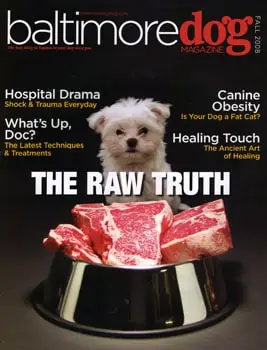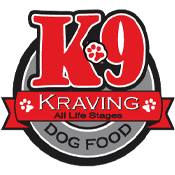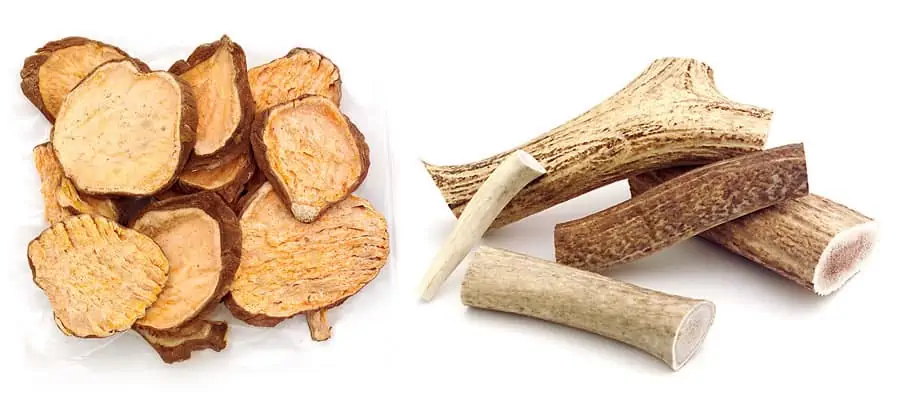The Raw Truth

By Tamara Granger
reprinted from the Baltimore Dog Magazine – Fall 2008 Articles
In the shadow of a shocking experience, the pet food recall in March 2007, a silver lining appears. “After the big scare, a lot of my customers had questions about their pet’s food and healthier alternatives. Simultaneously I saw manufacturers drifting to a greater [natural] approach to pet food,” recalled Virginia Byrns, co-owner of dogma for pets in Canton.
In the past, the average dog owner mainly had to decide between dry or canned. Today, the multiplicity of alternative choices and brands can be overwhelming as raw, grain-free and gluten-free have made a stronger presence in the general marketplace.
The alternative deemed most natural is the increasingly popular raw diet which mimics the predomesticated canines in-the-wild diet primarily of uncooked meat, skin, bones, and organs toting benefits of better skin and coat, whiter teeth, more efficient digestion and longevity, more naturally.
“The idea of feeding raw is not a fad, it is an evolution in the way of feeding based upon a better understanding what a dog’s dietary needs are for optimal health,” explains Lucy Postins, co-founder and lead nutritionist for The Honest Kitchen pet food. Pets are part of the family nowadays. People are truly invested in feeding their dogs well. It’s [a case of] pay now by feeding your dog quality, low-processed food or pay later in terms of increased vet bills, as an unhealthy consequence of a bad diet.”
An example of the difference an improved diet can make is Elphie, a Sheltie-mix, adopted by a Baltimore couple. Elphie was 6 months old and not house trained when adopted from the Animal Advocates of Howard County by Scott and Sharon Vail of Federal Hill. “In actuality she was incontinent and medication helped that, but we also discovered she had chronic acid reflux and loose stool,” remembered Sharon.
“Scott searched the Internet to find solutions to her other issues and stumbled on the raw diet theory. He felt it was a match to Elphie’s needs.”Sharon wasn’t so sure. “I was reluctant because a raw diet sounded gimmicky and gross. Even so, we decided to go for it.”
The changes in Elphie were almost immediate. “We noticed her stool firm up, she stopped vomiting after her meals and she started losing her excess weight. By the fourth week her frizzy coat appeared smoother and shinier.”
A raw diet means a few adjustments admits the Vails. “We spend more on her food than before, need to plan ahead to thaw out Elphie’s meals, her food looks gross and smells icky, but we are thrilled to have a happy, healthy dog.”
Just 10 years ago, there were a sprinkling of raw brands available to purchase, but predominately it was a grass-roots effort, as many devout raw followers were preparing their own pet’s meals at home. Today there are roughly 20 raw manufacturers nationwide, three of which are located in Maryland.
“Companies are making raw diets more convenient because it’s a rare person who wants to grind uncooked chicken necks in their own kitchen for their dog,” says Kevin Newton, store manager at All for the Pet in Severna Park.
“With the raw diet, there are now a lot of choices available from frozen to pasteurized to dehydrated. It does tend to cost more and not everyone can afford or wants to switch 100 percent, so in some cases our customers will mix a raw feed with a quality grain-free kibble. Others just stay with grain-free kibble because of the extended shelf life, ease in handling and overall convenience.”
Okay, but what does grain-free mean and what does it have to do with raw diet dog food? Grain-free stems from the “ancestral” approach to raw feed and the absence of cereal-type grains like oats, corn or wheat that are used by some dog food manufacturers as essential source of carbohydrates. It has been recognized that some dogs are actually grain intolerant. As a result, more health conscious kibble makers are using grain-free alternatives like potato, sweet potato or peas to supply carbohydrates.
Dr. Sean Delaney, senior executive vice president and chief scientific and medical officer of Natura Pet Products adds, “Grain-free foods that are also low in carbohydrates are similar to raw diets which should also be low in carbohydrates. Low carbohydrate foods have many potential benefits including increased palatability, higher energy density (meaning less volume needs to be fed and less feces need to be cleaned up), and positive effects on coat quality and body condition.”
According to Dr. Scott Sanderson, owner of the Animal Wellness Center, a holistic veterinary practice located in Columbia, some dogs are more genetically prone to digestive sensitivities; therefore, breed, medical history and age can help define whether or not the raw diet is most suitable for your dogs needs.
“We live in a toxic world; the air we breathe, the water we drink and the food we eat. Any living being requires the cleanest, healthiest fuel in their body for the best possible health.”
Dr. Christina Chambreau, homeopathic veterinarian, educator and author of the Healthy Animal Journal strongly recommends a wide variety of fresh food. “Each dog is unique. How do you know what diet is best for your dog? Observe your pet before and after you try different nutritional approaches. Track their overall health and disposition as you research feeding options that make sense for your lifestyle and are good for your dog.”
Dr. Chambreau recommends the following resources to study more about animal nutrition and alternative diets:
The Truth About Pet Foods: Rationale for Animal Nutrition by Dr. Randy Wysong
See Spot Live Longer by Steve Brown and Beth Taylor
Eat, Drink and Wag Your Tail (video)
Buy Local
Today there are roughly 20 raw manufacturers nationwide, three of which are located in Maryland.

When his 4-year-old German Shepherd died from a condition associated with his dog food, Bob Barrett of Baltimore and founder of K-9 Kraving knew he had to find a better alternative for his dogs. “At the time I owned a kennel raising German Shepherds imported from Germany and the cost per adult dog averaged $10K. Poor hip health and bloating was common with German Shepherds at relatively young ages and their life cycle was averaging only 10 to 11 years. I believed a better diet could help defy these likelihoods.” After researching several brands he learned that the package a dog food comes in is too often worth more than the product it contains. This made Barrett more determined to create a product with integrity and the proof to back it.
In 1999, based on the BARF (Biologically Appropriate Raw Food) values, Barrett founded K-9 Kraving Dog Food armed with a scientific formula geared for overall health, safety-certified ingredient sources and a USDA inspection legend lending testimony to his product’s integrity. Barrett adds, “The raw diet is about feeding your dog as Mother Nature intended to maintain your pet’s optimum health, longevity and reproductive capabilities. Our food has not been cooked, so all of the natural enzymes remain in tact, retaining maximum values of nutrients.”
Ruff & Rowdy Bison Chow is the offspring of a bigger idea. Trey and Angela Lewis of Monkton, owners of Gunpowder Bison & Trading Co., wanted to be farmers. They had beautiful acreage owned by Trey’s family for over 25 years and livestock was their goal. “We decided on bison because we admired the efforts happening by ranchers to repopulate them in the United States and that it provided a healthier alternative to red meat. Bison also fit the vision of what we wanted to create in an agricultural business, to stay local in what we were producing, leave a low carbon footprint and be able to network with other groups who are trying to do the same,” shared Angela. In March 2006 Gunpowder Bison & Trading Co. became a reality.
“Making dog food was not part of our original plan. But after learning more about the theory and benefits, it made sense and fit with our goal of utilizing as much of our livestock as possible in positive ways. Bison meat is leaner than chicken plus all of our bison are raised naturally, without hormones, antibiotics, or feed additives.” After the designated bison meat was quality inspected and nutritional values analyzed, the Lewis’ were able to begin production and in early 2007, Ruff & Rowdy Bison Chow joined the family business.
To learn more about Ruff & Rowdy Bison Chow, www.gunpowderbison.com .
Jennifer Boniface, founder and owner of Aunt Jeni’s Home Made, reveals, “I was driven from adolescence to young adulthood by my love for domestic animals. I completed my bachelor’s degree in animal science, took a few twists and turns, and became a CPA until fate eventually found me completing a master’s degree in animal nutrition science.”
Fate stepped in once more, and for her master’s thesis, Boniface was assigned to the National Zoo in Washington D.C., where her research focused on dietary control of Cystinuria in maned wolves. “We discovered that by manipulating their diet we could effectively control the severity of the maned wolves’ health problems associated with their genetic predisposition.”
Later, working one-on-one with pet owners as an animal nutritionist, she often recommended a specialized homemade diet to improve their pet’s health and was generally met with a lot of excuses. Then it all made sense. She could help clients by making their pet’s food for them. In 1999 Aunt Jeni’s Home Made products were launched.
Today Jennifer owns and operates her own FDA-inspected facility located in Temple Hills. “We are dedicated 100 percent to making the highest quality, freshest, all-natural and holistic pet food anywhere. It’s so important for pet owners to understand that a self-regulating body will seek its own proper pH when fed the right diet.” Boniface also offers lectures and seminars on animal nutrition.
To learn more about Aunt Jeni’s Home Made, go to: www.auntjeni.com .
Finding the correct diet for your pet could be an exhausting effort, but for both man and dog the reward is priceless.”
Safe Handling of Raw Diet Dog Food
• Keep packaged portions frozen until use
• Thaw packaged portions in a refrigerator
• Keep unused portions refrigerated, they will remain fresh 4-5 days while refrigerated
• Use non-porous stainless steel feeding bowls to prevent harboring of harmful bacteria
• Wash working surface, service ware and hands after handling
• Refrigerate or discard leftovers
• Salmonella, Escherichia coli (E. coli) and Listeria monocytogenes are three of the most harmful bacteria associated with raw foods. To prevent bacteria, do not leave any meat, poultry, fish or unpasteurized food items unrefrigerated.



